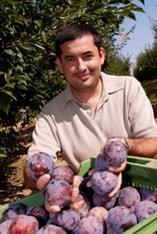
Extremadura, historically regarded as agriculturally underdeveloped despite its reputation for rice, processing tomatoes and high-quality hams, has become the largest single production area for plums in Europe, according to Miguel ángel Gomez, managing director of Afruex, the grower-exporters’ association.
He estimates that the region’s crop covers 6,000 hectares of a total of 13,000ha under fruit in the region, the remainder being shared equally by peaches and nectarines.
And his educated crystal ball tells him that the plum crop will expand by a further 15 per cent in volume terms, creating 10 per cent more orchards of heavy-cropping, black-skinned US- and Japanese-bred varieties.
While the major markets are the UK and Germany, many growers are optimistic that this can be expanded to include customers in the enlarged European community, who until now have predominantly supplied their markets with the more elongated, blue varieties like Switzen.
“Our most popular exports are Larry Anne, Fortune, and Angeleno, although we also supply Red Beaut, Pioneer, Black Beaut, Amber, Star, Prime Time and Villa Rosa. The combination allows our season to begin in May, with harvesting lasting through until August. And the storage capability of Angeleno means that we can market this variety as late as November,” says Gomez.
This is also the second year that Afruex has invested in a promotional campaign. Run by Foods from Spain in the UK, it is of relatively modest proportions, based on consumer and trade PR, although trolley posters and floor graphics in selected multiples are also part of the strategy.
As consumer demands change in the years to come, Extremadura’s growers have put the foundations in place to ensure they are well prepared.
“Even now, you can almost say that varieties are changing too fast for growers to adapt,” he says. “Already Sungold, for example, is being dropped as it does not ripen to the levels of colour specified by multiples.”
Undoubtedly, choice is not going to be a problem in the long term. A local trade press report claimed that there are no fewer than 47,000 new strains of stonefruit available, including some of the latest hybrids such as pluots and donut peaches already commercially grown in the US and being sold in the UK with names like Saturn and UFO.
Faced with this barely credible breadth of choice, growers and packers recognise the potential before them and are continuing to build for the future.
Cabanifut, an independent, family company with 550ha of stonefruit - of which plums account for 30 per cent - has already expanded its packhouse at a cost of €3 million (£1.6m), reveals its owner Nemesio Cabanillas. He plans to invest a further €2m by next season. “It will increase our capacity by 25 per cent,” he says.
Inevitably, the question that arises is what exactly has happened to lead to this boom? Simply enough, all the evidence points to the right mixture climate of economic viability. Water is the one commodity that is particularly expensive in this part of western Spain. The rivers, particularly the Tagus, already provide Spain with electricity and have created some of the largest dams in Spain.
“We have enough water at any one time to last for five years,” says Jose Riola, agronomist and quality controller for the second tier co-operative Acopaex, which incorporates 16 member groups. Set up in 1991, Acopaex now has 600ha of fruit as well as growing salads and vegetables.
The drip-irrigated plum orchards on the 60ha Finca Navisa are unique, as they are owned by the local town council but run as a private company. “Reduction of pesticides is a priority,” says farm director Santiago Sanchez, revealing the company is monitoring infertile fruit-fly breeding programmes in the US as the latest means of switching to biological control.
As members of EurepGAP, small growers are also getting the message, adds Riola, who operates a strict monitoring system on treatments and their records. “Initially, there was some resistance to these extra disciplines, but now they realise that without such safeguards, it is almost impossible to export,” he says.



